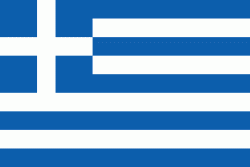Larissa Prefecture (Nomós Larísis)
Larissa is the second largest regional unit in Greece, exceeded only by Aetolia-Acarnania. It covers about one-third of Thessaly. It borders the regional units of Kozani to the northwest, Pieria to the northeast, the Aegean Sea to the east, Magnesia to the southeast, Phthiotis to the south, Karditsa to the southwest and Trikala to the west.
The tallest mountain in Greece, Mount Olympus (2,917 m) is situated in the northeastern part of the regional unit. Mount Ossa is situated in the east, at the Aegean coast. The lower stretch of the river Pineios flows through the Vale of Tempe, between Olympus and Ossa.
The northern part is covered with forests, but most of the regional unit is fertile land, the Thessalian Plain.
Map - Larissa Prefecture (Nomós Larísis)
Map
Country - Greece
 |
 |
| Flag of Greece | |
Greece is considered the cradle of Western civilization, being the birthplace of democracy, Western philosophy, Western literature, historiography, political science, major scientific and mathematical principles, theatre and the Olympic Games. From the eighth century BC, the Greeks were organised into various independent city-states, known as poleis (singular polis), which spanned the Mediterranean and the Black Sea. Philip II of Macedon united most of present-day Greece in the fourth century BC, with his son Alexander the Great rapidly conquering much of the ancient world, from the eastern Mediterranean to the North Western parts of India. The subsequent Hellenistic period saw the height of Greek culture and influence in antiquity. Greece was annexed by Rome in the second century BC, becoming an integral part of the Roman Empire and its continuation, the Byzantine Empire, which was culturally and linguistically predominantly Greek.
Currency / Language
| ISO | Currency | Symbol | Significant figures |
|---|---|---|---|
| EUR | Euro | € | 2 |
| ISO | Language |
|---|---|
| EN | English language |
| FR | French language |
| EL | Greek language |















